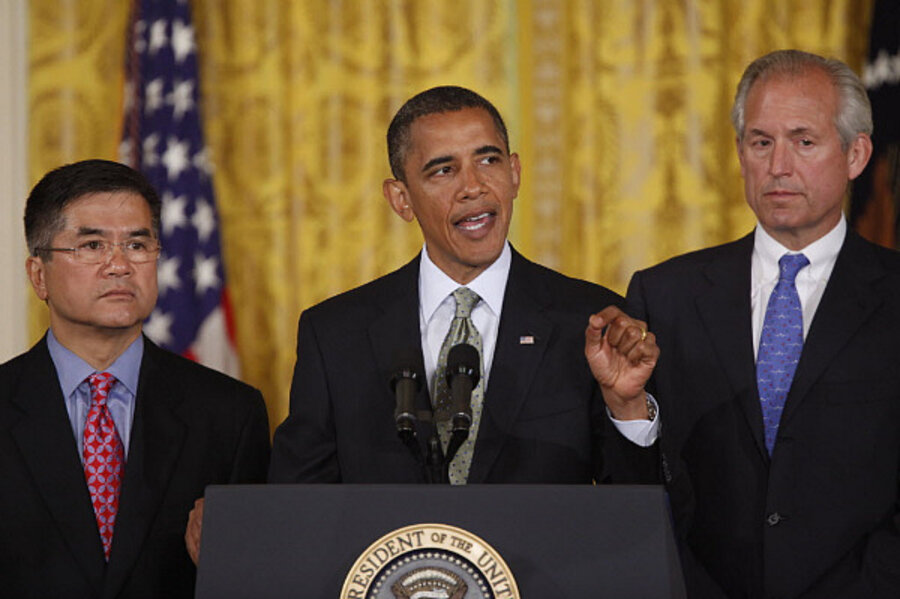Obama touts bright spot in the US economy: rising US exports
President Obama touted a bright spot in the US economy Wednesday, pointing to rising exports as a building block of recovery.
He said exports so far this year are running at a pace 17 percent ahead of the same period last year.
"This is where American jobs will be tomorrow," Mr. Obama said in remarks that highlighted progress for his National Export Initiative. "Ninety-five percent of the world’s customers and fastest-growing markets are beyond our borders."
The refrain is part of a broader White House message as this fall's congressional elections come into view: that the president has a strategy for creating much-needed jobs in the US.
Headwinds are facing the Obama administration on several fronts: The unemployment rate is 9.5 percent, job growth in the private sector is tepid, and Congress doesn't appear to have much appetite for added economic stimulus projects. With domestic consumers and the federal government facing constraints, trade is an obvious place to turn for job growth.
Already, exports account for 10.3 million US jobs, or 7 percent of the total, Obama said in remarks after meeting with his export council. His goal, announced early this year, is to add another 2 million or so jobs in this arena, by doubling America's exports within five years.
Economists widely agree that, in an integrated world economy, the US must look to export-related jobs as a crucial source of growth. But if the latest trade numbers show some progress, they also underscore that it won't be easy for Obama to achieve his export goals.
Part of the past year's export growth, Obama acknowledged, relates simply to a rebound from the depths of recession. But he said his policies are also helping. Exports will have to keep growing at the recent pace to reach his goal.
In the past quarter-century, exports have never doubled in a five-year period, according to an analysis this spring by Sven Jari Stehn, an economist at Goldman Sachs. The report said Obama's "very ambitious" goal might be reached if the world economy posts strong growth (4.5 percent a year) and the US dollar declines 30 percent in value against other currencies.
The most rapid doubling of US exports in the recent past, which occurred during a seven-year stretch in the 1980s, coincided with a declining dollar and a booming global economy.
Obama's export initiative includes steps on several fronts:
Efforts to remove barriers to trade. Two recent examples together may be worth $1 billion to US exporters. A March deal reopened the Chinese market to US pork and pork products. A June agreement opened Russia once again to US poultry exports. Obama is also trying to revive progress toward a trade-widening pact with South Korea.
Enforcement of trade rules. In one prominent ruling Last week, the World Trade Organization said that European governments subsidized Airbus’s large civil aircraft.
Advocating a rebalanced global economy. In meetings like the recent gathering of leaders from the G20 nations, the US hopes to nudge other nations toward greater domestic consumption and less reliance on US consumers for demand.
More access to financing. The Export-Import Bank has more than doubled its loans to support American exporters from the same period last year.
On Wednesday, Obama also announced the names of business leaders who will serve on his export council, chaired by Boeing CEO Jim McNerney.
A challenge, acknowledged by Obama, is that other nations won't be standing still as the US tries to enlarge its role as an exporter. Even as US exports have been growing, imports to the US have continued to rise. And those imports include lots of things other than oil.
The US imported $281 billion more in consumer goods during 2009 than it exported. Imports have been gaining market share in many advanced products as well as in industries that emphasize less-skilled labor. By comparison, the negative trade balance in energy products totaled $221 billion.
A new report by the McKinsey Global Institute finds that other nations, including emerging-market economies, are "making huge strides" in becoming attractive places for multinational firms to put down roots for production and research. The report cited interviews with corporate executives who said US tax policies, bureaucratic hurdles, and limits on immigration of skilled workers may be discouraging investment in the US.
Related:
Troubling reason for drop in unemployment rate: People exiting work force





